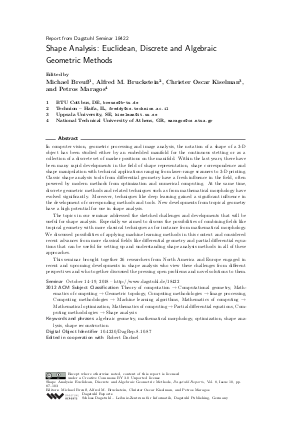Shape Analysis: Euclidean, Discrete and Algebraic Geometric Methods (Dagstuhl Seminar 18422)
Authors Michael Breuß, Alfred M. Bruckstein, Christer Oscar Kiselman, Petros Maragos and all authors of the abstracts in this report
-
Part of:
Issue:
Dagstuhl Reports, Volume 8, Issue 10
Part of: Volume: Dagstuhl Reports, Volume 8
Part of: Journal: Dagstuhl Reports (DagRep) - License:
 Creative Commons Attribution 3.0 Unported license
Creative Commons Attribution 3.0 Unported license
- Publication Date: 2019-04-04
File

PDF
DagRep.8.10.87.pdf
- Filesize: 3.68 MB
- 17 pages
Document Identifiers
Subject Classification
Keywords
- algebraic geometry
- mathematical morphology
- optimization
- shape analysis
- shape reconstruction
Metrics
- Access Statistics
-
Total Accesses (updated on a weekly basis)
0Document
0Metadata
Abstract
In computer vision, geometric processing and image analysis, the notation of a shape of a 3-D object has been studied either by an embedded manifold for the continuous stetting or as a collection of a discrete set of marker positions on the manifold. Within the last years, there have been many rapid developments in the field of shape representation, shape correspondence and shape manipulation with technical applications ranging from laser-range scanners to 3-D printing. Classic shape analysis tools from differential geometry have a fresh influence in the field, often powered by modern methods from optimization and numerical computing. At the same time, discrete geometric methods and related techniques such as from mathematical morphology have evolved significantly. Moreover, techniques like deep learning gained a significant influence in the development of corresponding methods and tools. New developments from tropical geometry have a high potential for use in shape analysis. The topics in our seminar addressed the sketched challenges and developments that will be useful for shape analysis. Especially we aimed to discuss the possibilities of combining fields like tropical geometry with more classical techniques as for instance from mathematical morphology. We discussed possibilities of applying machine learning methods in this context and considered recent advances from more classical fields like differential geometry and partial differential equations that can be useful for setting up and understanding shape analysis methods in all of these approaches. This seminar brought together 26 researchers from North America and Europe engaged in recent and upcoming developments in shape analysis who view these challenges from different perspectives and who together discussed the pressing open problems and novel solutions to them.
Cite As Get BibTex
Michael Breuß, Alfred M. Bruckstein, Christer Oscar Kiselman, and Petros Maragos. Shape Analysis: Euclidean, Discrete and Algebraic Geometric Methods (Dagstuhl Seminar 18422). In Dagstuhl Reports, Volume 8, Issue 10, pp. 87-103, Schloss Dagstuhl – Leibniz-Zentrum für Informatik (2019)
https://doi.org/10.4230/DagRep.8.10.87
BibTex
@Article{breu_et_al:DagRep.8.10.87,
author = {Breu{\ss}, Michael and Bruckstein, Alfred M. and Kiselman, Christer Oscar and Maragos, Petros},
title = {{Shape Analysis: Euclidean, Discrete and Algebraic Geometric Methods (Dagstuhl Seminar 18422)}},
pages = {87--103},
journal = {Dagstuhl Reports},
ISSN = {2192-5283},
year = {2019},
volume = {8},
number = {10},
editor = {Breu{\ss}, Michael and Bruckstein, Alfred M. and Kiselman, Christer Oscar and Maragos, Petros},
publisher = {Schloss Dagstuhl -- Leibniz-Zentrum f{\"u}r Informatik},
address = {Dagstuhl, Germany},
URL = {https://drops.dagstuhl.de/entities/document/10.4230/DagRep.8.10.87},
URN = {urn:nbn:de:0030-drops-103499},
doi = {10.4230/DagRep.8.10.87},
annote = {Keywords: algebraic geometry, mathematical morphology, optimization, shape analysis, shape reconstruction}
}
